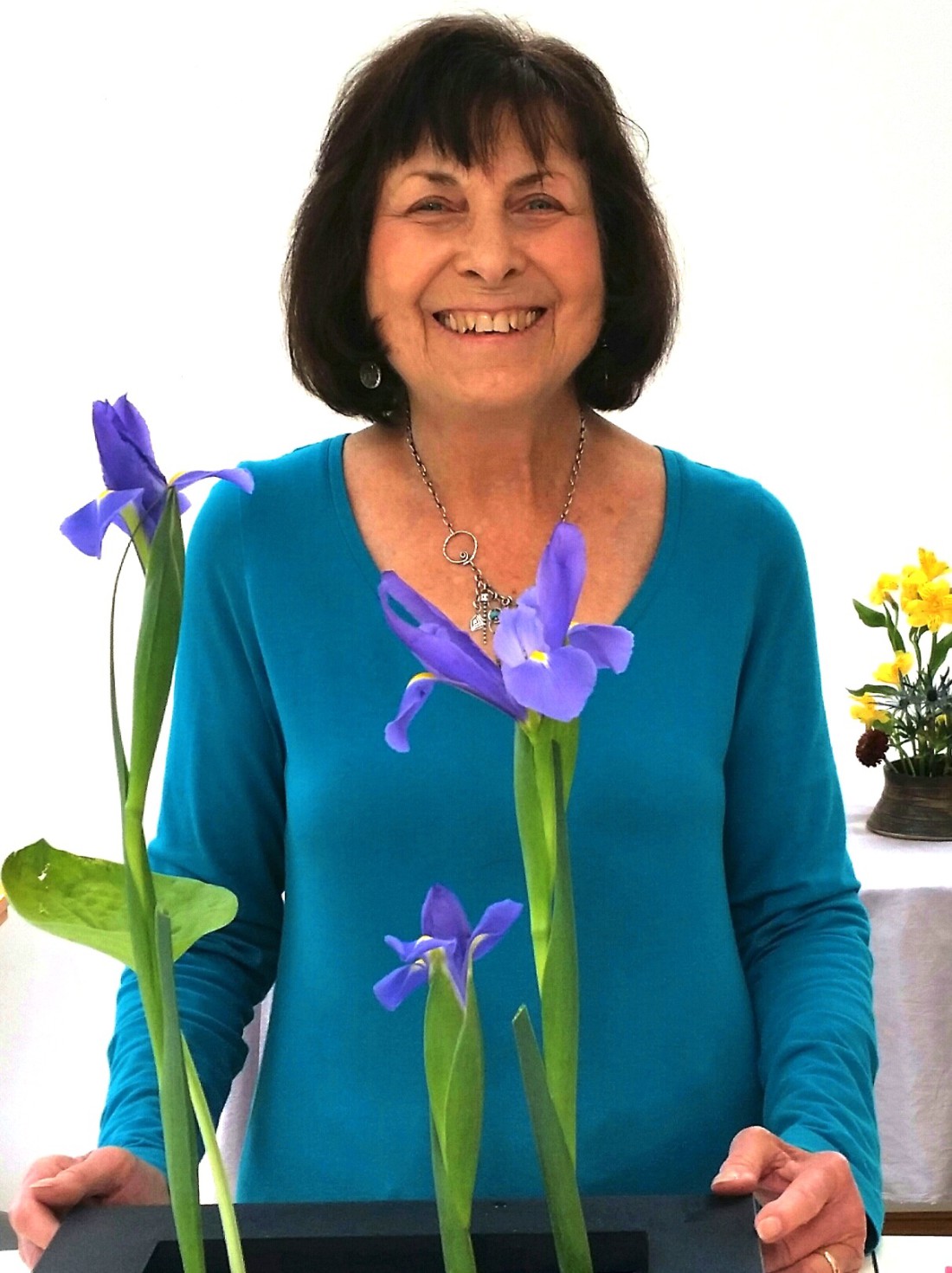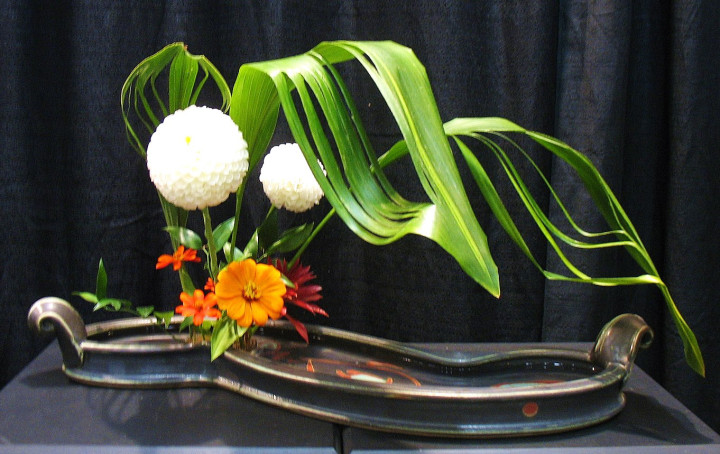“I love that twist in the iris leaves.”
“Bring this forward a little bit.”
“You’ve got a nice bend in that stem of grass.”
“Make these roses a little shorter, so when they’re on your coffee table you’re looking right into them.”
In the light-filled studio behind her East Asheville home, Norma Bradley is teaching ikebana, the centuries-old Japanese “way of flowers.” With these and similar comments, she passes on the art’s fundamental principles: depth, movement, openness. Space, rhythm, proportion. Parameters of grace. Indicators of life. A health-enhancing immersion in the details of beauty.
“Ikebana” means both “flower arrangement” and “living flowers.” Several schools of the art have emerged over its long history, each with a different focus. The “ichiyo” style, which Bradley teaches as a certified master instructor, values personal interpretation and imagination in harmonizing each arrangement with the environment it will inhabit. She’s an active member of Ikebana International’s Asheville chapter, which has a sister group in Hendersonville (the Blue Ridge chapter of the Ikenobo Ikebana Society).
Bradley teaches the art as a practice of mindfulness and community.
She begins the two-hour class by inviting her students to return to their “true home in the here and now,” sounding a Tibetan bowl and offering them an inspirational reading. The students consult their textbooks and identify the form they’ll be learning and making that session — symmetrical, ascending, contrast, asymmetrical balanced or heaven and earth.
Working in silence, they select containers, flowers and line materials — branches, leaves and grasses. They venture into Bradley’s garden, just a step beyond the studio’s glass door, and supplement the flowers she’s purchased for them.
An attraction to particular flowers opens a dialogue and begins the intimate communication between nature and person. Betsey Baker, one of Bradley’s students, explains, “I choose the flowers I’m going to work with. And then I let the flowers tell me where they want to be.”
She says ikebana engages her mind and body, spirit and soul. The act becomes a meditation, with a focus on well-being. Inspiration “comes from my gut; it comes from within,” she adds. “It’s a soul-producing art.”
As students realize a particular form, Bradley responds to their questions, creating an atmosphere that’s encouraging, nurturing, free from worry.
“Norma sets a beautiful tone,” says Barbara Katzenberg, another student. “It helps us so much. I like her saying, ‘Let’s not bring any worries or concerns into class; let’s just focus on what we’re doing’ — because then it is a meditation. If you can just stay focused, it’s amazing.”
Joy Letsinger, who hadn’t thought of herself as “creative” before taking Bradley’s classes, says there’s no expectation, no pressure and no hurry. “It’s not about performance,” she says.
Their arrangements complete, the students sketch them in their journals. Then they write and share their thoughts about their creative process and the ways in which the forms relate to their lives.
In one class, for example, Katzenberg had made an ascending arrangement. She talked about the form in relation to striving for good thoughts, good words and good deeds. The process involved some frustration.
“Frustration is part of the creative process,” says Bradley. “If there’s no frustration, it’s not a creative process.
During the same session, Kimberly Childs had worked with the heaven-and-earth form. She wrote at the time, “Coming to ikebana today is centering and relaxing. Heaven on earth is here at Norma’s. Beauty, peace, birdsong, creativity is what I receive here. It is a blessing and a gift to be here and inherently healing. Here we widen our perceptions to include silence, stillness, peace and joy.”
At another class, students admired Katzenberg’s simple yet spectacular symmetrical form. “When I came to class,” she recalls, “I was drawn to the tall violet flowers and selected a stalk for the centerpiece. I didn’t want anything else to take the focus away from that, so I thought of grasses, which are light, airy and can radiate outward. I added the grasses and a smaller stalk of the purple flowers to peek out of the front opening in the base. This arrangement seemed so easy and almost effortless to complete. Less really is more.”
While Katzenberg’s arrangement demonstrated vertical symmetry, left and right sides mirroring each other, Frieda Probst created an arrangement with radial symmetry. “I wanted this arrangement to be symmetrical from all sides, as I wish to see my life — as above, so below,” she says. “I celebrate all viewpoints of my life.”
The talk at the end of each class creates a rich community of mutual support and appreciation. “We’re all so happy when each other does a good thing,” Probst says. “It’s not a competition. We’re happy for each other. We love the beauty in each other’s work.”
As students get ready to leave, they prepare to take home the arrangements they’ve made. “It’s always wonderful to have ikebana arrangements around the house,” says Childs. “They help me to stop and refocus on what is really important — living my life with mindful grace.”
How does ikebana contribute to health and healing? Bradley sees her students growing in self-confidence, working through fear and resistance, experiencing and expressing their own creativity like never before, she explains.
Anna Matheson had never sketched or written a haiku (a Japanese form of poetry), for example. Drawing and writing in Bradley’s classes changed that. Matheson created a calendar that grouped photos of her 20 arrangements with corresponding sketches and poems.
Ikebana is a practice in mindfulness, says Bradley. “You’re getting out of the mind and getting into the moment. You’re not worried about yourself; you’re not worried about what you’re going to do an hour from now. You’re right there with the flowers and the line material. You’re paying attention to detail. That gives depth. Being present brings healing.”
Childs speaks from experience about the healing aspect of ikebana, this soul-producing art: “I started doing ikebana during a time of poor health,” she says. “In the focus on peace and beauty at Norma’s, I found a refuge. The gentle loving appreciation of nature was what I took away. Ikebana became a lifeline to feelings of well-being and peace.”
Art in Bloom
Norma Bradley and Betsey Baker are among the artists participating in the June 18-20 Black Mountain Center for the Arts annual Art in Bloom show, which pairs flower arrangements with paintings and sculptures.
FLOWING IN SPACE: Ikebana instructor Norma Bradley composed this free- form arrangement at the 2014 Southern Highland Craft Guild’s Craft Fair. Container by Nick Joerling. Photo by Norma Bradley





Your article beautifully described Ikebana and the benefits of this Japanese art form. From your writing I got a clear picture of Norma and her classes. If I were still living in the Asheville area I would want to study Ikebana with Norma. But, I now live in Japan.
Barbara, thanks so much for your comment and appreciation. I can only imagine the beauty available to you now as you live within Japanese culture.
In case you’d like a peek into the contribution my father, Homer Sarasohn, made to post-war Japan, visit http://honoringhomer.net
Warmly,
Lisa
This article was flawlessly written and created interest for me in a subject I knew nothing about. I can’t wait to read more by this author!
Denise, thanks so much for your huzzah! Who knew flower arranging — easily dismissed in our go-get-’em culture as a trivial pursuit — could be such a path to aligning with life itself!